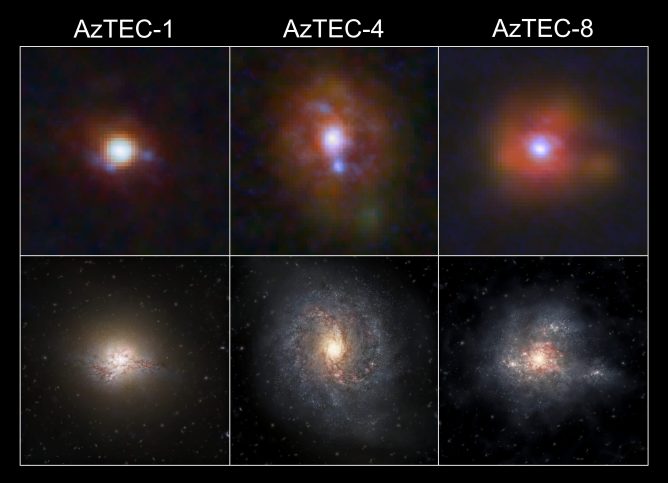2019.11.18
ALMA Reveals Origin of Mysterious Blast: AT2018cow originated from supernova in a strongly-magnetized, dense environment
One possible scenario for this mysterious blast is that AT2018cow’s progenitor was similar to those of other stellar explosions but was surrounded by a large amount of material before its explosion. In this scenario, the explosion produced relativistic jets with synchrotron emission and also generated polarized light. The team successfully confirmed the characterized peak frequency caused by the synchrotron emission. But surprisingly, the ALMA polarimetry did not detect the expected polarized light from AT2018cow.
The research team interpreted this to mean that the dense surrounding material and strong magnetic field played important roles in suppressing the polarization. Under these conditions, the Faraday rotation effect, which is an interaction between light and a magnetic field in a medium, is strong. The synchrotron emissions from different parts in the relativistic jets have different Faraday rotation effects, which lead to suppression of the net polarization.
The research team emphasized that these ALMA observations establish a specific method for multi-messenger astronomy (observations of differing signals, such as electromagnetic radiation, gravitational waves, neutrinos, or cosmic rays) with this kind of transients. Based on their 230 GHz observations, the maximum energy of the accelerated particles reached at least GeV level. Since observations at higher frequencies are key to estimating the lower limit for the maximum energy of the particles, ALMA polarimetry at a higher frequency (i.e. ~THz) could examine whether AT2018cow-like objects are the origin of PeV cosmic rays. The origin of cosmic rays is still a crucial issue in high-energy astrophysics.
Paper and Research Team
These observation results were published as Huang, Shimoda, Urata, Toma et al. “ALMA Polarimetry of AT2018cow” in Astrophysical Journal Letters.
The research team members are:
Kuiyun Huang (CYCU), Jiro Shimoda (Tohoku Univ.), Yuji Urata (NCU), Kenji Toma (Tohoku Univ.), Kazutaka Yamaoka (Nagoya Univ.), Keiichi Asada (ASIAA), Hiroshi Nagai (NAOJ/SOKENDAI), Satoko Takahashi (JAO/NAOJ/SOKENDAI), Glen Petitpas (Harvard-Smithsonian Center for Astrophysics), Makoto Tashiro (Saitama Univ.)
This work is supported by the Ministry of Science and Technology of Taiwan grants MOST 105-2112-M-008-013-MY3 and 106-2119-M-001-027. This work is also supported by JSPS Grants-in-Aid for Scientific Research No. 18H01245.
The Atacama Large Millimeter/submillimeter Array (ALMA), an international astronomy facility, is a partnership of the European Organisation for Astronomical Research in the Southern Hemisphere (ESO), the U.S. National Science Foundation (NSF) and the National Institutes of Natural Sciences (NINS) of Japan in cooperation with the Republic of Chile. ALMA is funded by ESO on behalf of its Member States, by NSF in cooperation with the National Research Council of Canada (NRC) and the Ministry of Science and Technology (MOST) and by NINS in cooperation with the Academia Sinica (AS) in Taiwan and the Korea Astronomy and Space Science Institute (KASI). ALMA construction and operations are led by ESO on behalf of its Member States; by the National Radio Astronomy Observatory (NRAO), managed by Associated Universities, Inc. (AUI), on behalf of North America; and by the National Astronomical Observatory of Japan (NAOJ) on behalf of East Asia. The Joint ALMA Observatory (JAO) provides the unified leadership and management of the construction, commissioning and operation of ALMA.










